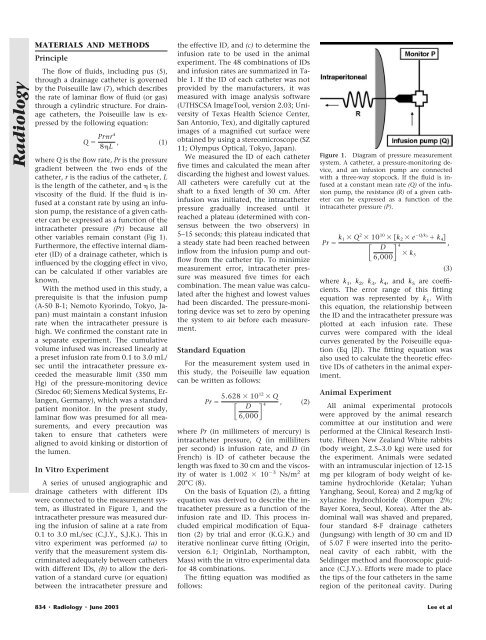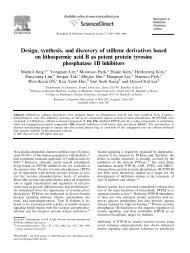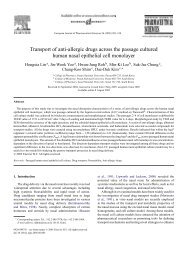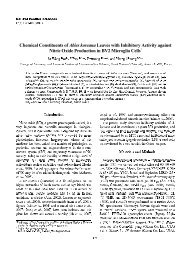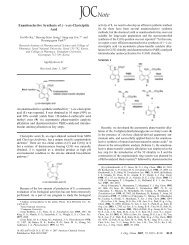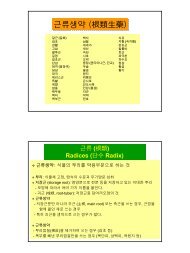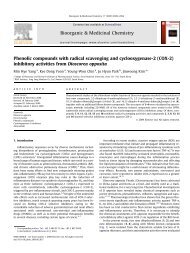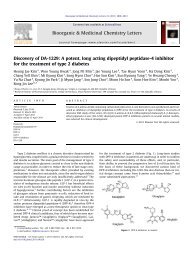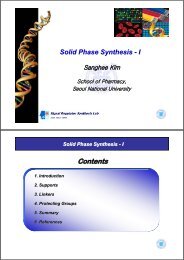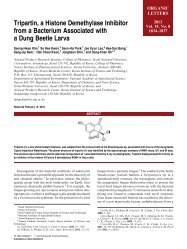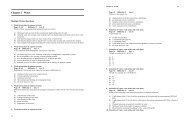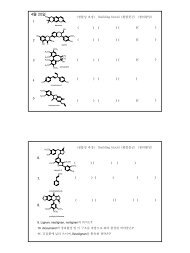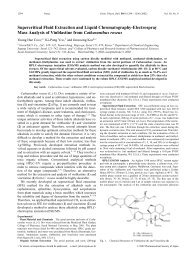Clogging of Drainage Catheters: Quantitative and Longitudinal ...
Clogging of Drainage Catheters: Quantitative and Longitudinal ...
Clogging of Drainage Catheters: Quantitative and Longitudinal ...
Create successful ePaper yourself
Turn your PDF publications into a flip-book with our unique Google optimized e-Paper software.
Radiology<br />
MATERIALS AND METHODS<br />
Principle<br />
The flow <strong>of</strong> fluids, including pus (5),<br />
through a drainage catheter is governed<br />
by the Poiseuille law (7), which describes<br />
the rate <strong>of</strong> laminar flow <strong>of</strong> fluid (or gas)<br />
through a cylindric structure. For drainage<br />
catheters, the Poiseuille law is expressed<br />
by the following equation:<br />
Q Prr4<br />
8L , (1)<br />
where Q is the flow rate, Pr is the pressure<br />
gradient between the two ends <strong>of</strong> the<br />
catheter, r is the radius <strong>of</strong> the catheter, L<br />
is the length <strong>of</strong> the catheter, <strong>and</strong> is the<br />
viscosity <strong>of</strong> the fluid. If the fluid is infused<br />
at a constant rate by using an infusion<br />
pump, the resistance <strong>of</strong> a given catheter<br />
can be expressed as a function <strong>of</strong> the<br />
intracatheter pressure (Pr) because all<br />
other variables remain constant (Fig 1).<br />
Furthermore, the effective internal diameter<br />
(ID) <strong>of</strong> a drainage catheter, which is<br />
influenced by the clogging effect in vivo,<br />
can be calculated if other variables are<br />
known.<br />
With the method used in this study, a<br />
prerequisite is that the infusion pump<br />
(A-50 B-1; Nemoto Kyorindo, Tokyo, Japan)<br />
must maintain a constant infusion<br />
rate when the intracatheter pressure is<br />
high. We confirmed the constant rate in<br />
a separate experiment. The cumulative<br />
volume infused was increased linearly at<br />
a preset infusion rate from 0.1 to 3.0 mL/<br />
sec until the intracatheter pressure exceeded<br />
the measurable limit (350 mm<br />
Hg) <strong>of</strong> the pressure-monitoring device<br />
(Siredoc 60; Siemens Medical Systems, Erlangen,<br />
Germany), which was a st<strong>and</strong>ard<br />
patient monitor. In the present study,<br />
laminar flow was presumed for all measurements,<br />
<strong>and</strong> every precaution was<br />
taken to ensure that catheters were<br />
aligned to avoid kinking or distortion <strong>of</strong><br />
the lumen.<br />
In Vitro Experiment<br />
A series <strong>of</strong> unused angiographic <strong>and</strong><br />
drainage catheters with different IDs<br />
were connected to the measurement system,<br />
as illustrated in Figure 1, <strong>and</strong> the<br />
intracatheter pressure was measured during<br />
the infusion <strong>of</strong> saline at a rate from<br />
0.1 to 3.0 mL/sec (C.J.Y., S.J.K.). This in<br />
vitro experiment was performed (a) to<br />
verify that the measurement system discriminated<br />
adequately between catheters<br />
with different IDs, (b) to allow the derivation<br />
<strong>of</strong> a st<strong>and</strong>ard curve (or equation)<br />
between the intracatheter pressure <strong>and</strong><br />
the effective ID, <strong>and</strong> (c) to determine the<br />
infusion rate to be used in the animal<br />
experiment. The 48 combinations <strong>of</strong> IDs<br />
<strong>and</strong> infusion rates are summarized in Table<br />
1. If the ID <strong>of</strong> each catheter was not<br />
provided by the manufacturers, it was<br />
measured with image analysis s<strong>of</strong>tware<br />
(UTHSCSA ImageTool, version 2.03; University<br />
<strong>of</strong> Texas Health Science Center,<br />
San Antonio, Tex), <strong>and</strong> digitally captured<br />
images <strong>of</strong> a magnified cut surface were<br />
obtained by using a stereomicroscope (SZ<br />
11; Olympus Optical, Tokyo, Japan).<br />
We measured the ID <strong>of</strong> each catheter<br />
five times <strong>and</strong> calculated the mean after<br />
discarding the highest <strong>and</strong> lowest values.<br />
All catheters were carefully cut at the<br />
shaft to a fixed length <strong>of</strong> 30 cm. After<br />
infusion was initiated, the intracatheter<br />
pressure gradually increased until it<br />
reached a plateau (determined with consensus<br />
between the two observers) in<br />
5–15 seconds; this plateau indicated that<br />
a steady state had been reached between<br />
inflow from the infusion pump <strong>and</strong> outflow<br />
from the catheter tip. To minimize<br />
measurement error, intracatheter pressure<br />
was measured five times for each<br />
combination. The mean value was calculated<br />
after the highest <strong>and</strong> lowest values<br />
had been discarded. The pressure-monitoring<br />
device was set to zero by opening<br />
the system to air before each measurement.<br />
St<strong>and</strong>ard Equation<br />
For the measurement system used in<br />
this study, the Poiseuille law equation<br />
can be written as follows:<br />
Pr 5.628 1012 Q<br />
<br />
6,000<br />
D 4 , (2)<br />
where Pr (in millimeters <strong>of</strong> mercury) is<br />
intracatheter pressure, Q (in milliliters<br />
per second) is infusion rate, <strong>and</strong> D (in<br />
French) is ID <strong>of</strong> catheter because the<br />
length was fixed to 30 cm <strong>and</strong> the viscosity<br />
<strong>of</strong> water is 1.002 10 3 Ns/m 2 at<br />
20°C (8).<br />
On the basis <strong>of</strong> Equation (2), a fitting<br />
equation was derived to describe the intracatheter<br />
pressure as a function <strong>of</strong> the<br />
infusion rate <strong>and</strong> ID. This process included<br />
empirical modification <strong>of</strong> Equation<br />
(2) by trial <strong>and</strong> error (K.G.K.) <strong>and</strong><br />
iterative nonlinear curve fitting (Origin,<br />
version 6.1; OriginLab, Northampton,<br />
Mass) with the in vitro experimental data<br />
for 48 combinations.<br />
The fitting equation was modified as<br />
follows:<br />
Figure 1. Diagram <strong>of</strong> pressure measurement<br />
system. A catheter, a pressure-monitoring device,<br />
<strong>and</strong> an infusion pump are connected<br />
with a three-way stopcock. If the fluid is infused<br />
at a constant mean rate (Q) <strong>of</strong> the infusion<br />
pump, the resistance (R) <strong>of</strong> a given catheter<br />
can be expressed as a function <strong>of</strong> the<br />
intracatheter pressure (P).<br />
Pr k 1 Q 2 10 10 k 2 e Q/k3 k 4 <br />
<br />
6,000<br />
D 4 ,<br />
k 5<br />
(3)<br />
where k 1 , k 2 , k 3 , k 4 , <strong>and</strong> k 5 are coefficients.<br />
The error range <strong>of</strong> this fitting<br />
equation was represented by k 1 . With<br />
this equation, the relationship between<br />
the ID <strong>and</strong> the intracatheter pressure was<br />
plotted at each infusion rate. These<br />
curves were compared with the ideal<br />
curves generated by the Poiseuille equation<br />
(Eq [2]). The fitting equation was<br />
also used to calculate the theoretic effective<br />
IDs <strong>of</strong> catheters in the animal experiment.<br />
Animal Experiment<br />
All animal experimental protocols<br />
were approved by the animal research<br />
committee at our institution <strong>and</strong> were<br />
performed at the Clinical Research Institute.<br />
Fifteen New Zeal<strong>and</strong> White rabbits<br />
(body weight, 2.5–3.0 kg) were used for<br />
the experiment. Animals were sedated<br />
with an intramuscular injection <strong>of</strong> 12-15<br />
mg per kilogram <strong>of</strong> body weight <strong>of</strong> ketamine<br />
hydrochloride (Ketalar; Yuhan<br />
Yanghang, Seoul, Korea) <strong>and</strong> 2 mg/kg <strong>of</strong><br />
xylazine hydrochloride (Rompun 2%;<br />
Bayer Korea, Seoul, Korea). After the abdominal<br />
wall was shaved <strong>and</strong> prepared,<br />
four st<strong>and</strong>ard 8-F drainage catheters<br />
(Jungsung) with length <strong>of</strong> 30 cm <strong>and</strong> ID<br />
<strong>of</strong> 5.07 F were inserted into the peritoneal<br />
cavity <strong>of</strong> each rabbit, with the<br />
Seldinger method <strong>and</strong> fluoroscopic guidance<br />
(C.J.Y.). Efforts were made to place<br />
the tips <strong>of</strong> the four catheters in the same<br />
region <strong>of</strong> the peritoneal cavity. During<br />
834 Radiology June 2003 Lee et al


